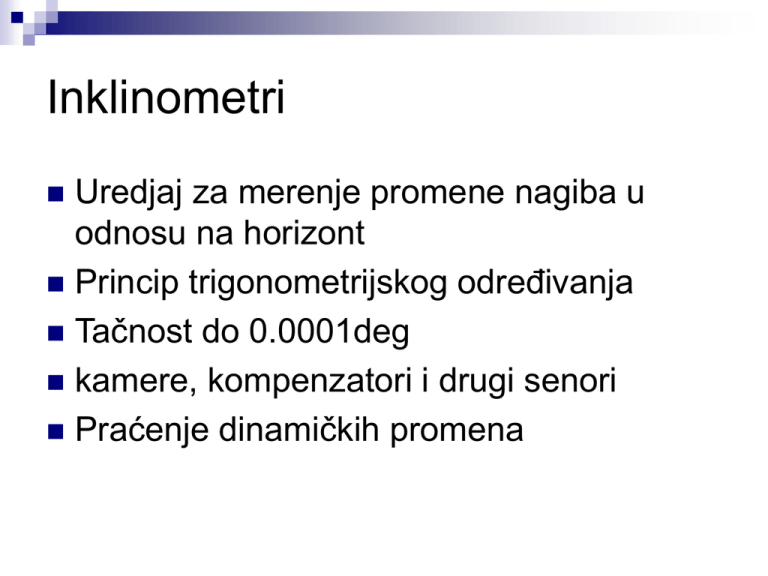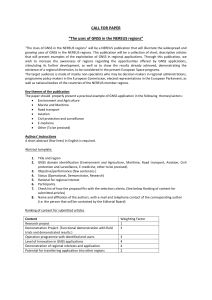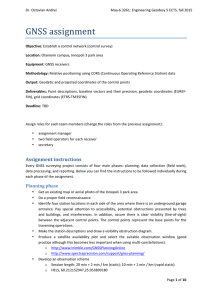modern methods of dinamic setting out in engineering
advertisement

Inklinometri Uredjaj za merenje promene nagiba u odnosu na horizont Princip trigonometrijskog određivanja Tačnost do 0.0001deg kamere, kompenzatori i drugi senori Praćenje dinamičkih promena MODERN METHODS OF DINAMIC SETTING OUT IN ENGINEERING SURVEYING Modern trends in building constructions Methodology for survey setting out of high rise structures Such extremely high and thin constructions have become a matter of prestige in the countries where they are built, and became symbols of the cities where they are located. Empire State Building – 381 m, 1931. Petronas Tower in Malaysia – 482 m, 1998. Taipai 101, Taiwan – 508 m, 2004. Burj Dubai – 750 m, 2008. Burj Dubai Petronas Tower Empire State Bulding Taipei Geodesy as a vital segment in the process of design and construction of such facilities must develop a new technology of setting out and control of setting out that is appropriate to the construction conditions. It is primarily to detect and eliminate the influence of wind, facade heating from the sun and dynamic movement of structure due to the dynamic movement of crane with different values of the load being lifted and assembled at the asymmetric position on the platform at the current level of construction. Basic problems of dinamic setting out Conventional methods of work are not giving satisfactory results in designing and construction of high and thin structures, because at the time of setting out and control of setting out at the platforms over 50 m high, structure is affected by wind (different speeds and directions), asymmetric loads caused by different loads lifted up or down by crane, as well as by variable heating caused by the sun in the already built parts of the structure Transmission of the axis of structure during conventional methods of construction Schematic view of the external influences on the position of marked points Long term displacement Daily changes of position Dynamic movements Project of setting out the CMA Tower in Riyad, Saudi Arabia By presenting the Project of survey setting out of CMA Tower in Riyadh (Saudi Arabia), height 540 m, prepared by Leica Company expert team, complexity of survey setting out of tall buildings is highlighted. GEODETIC BASE OF DESIGN Local geodetic network is designed and realized with accuracy of coordinates and levels that must be in function of the required accuracy of setting out Setting out on lower levels Setting out on higher levels CONCEPT OF DYNAMIC SETTING OUT Automated total station (TPS) GNSS Precision inclinometer Concept of dynamic setting out, proposed and used by Leica experts for setting out of characteristic points of high structures, is based on system that consists of minimum 3 GNSS receivers, with 360° prism under receiver’s antenna, positioned on the platform on which setting out is carried, automatic total station (TS) whose coordinates are determined by backsight crossing of minimum 3 GPS devices and which is used for polar setting out of characteristic points of the structure on the level of the platform as well as system of very precise inclinometers networked along the structure’s main axis. Total stations provide the measurements of horizontal and vertical directions and slope length to the points of active control network in order to determine the definitive spatial positions of observation station / total stations, which are pre-determined by GNSS measurements The role of GNSS relates to securing the spatial positioning of a TPS by using the method of backsight crossing Precision inclinometer is a device for very precise measuring of structure’s main axis slope change referring to the designed vertical. This device must be installed and in function during the entire construction process, when the structure is exposed to all unwanted outside effects. Concept of dynamic setting out during monitoring of construction of CMA Tower in Riyadh TPS – Automatic Total Station GNSS (GPS and GLONASS) Precise inclinometer (Leica NIVEL200 and WYLER Zeromatic Inclinometer) Each component must be calibrated and set-up on place accordingly factory recommendations System TPS/GNSS/precise inclinometer for the construction of high-rise buildings All components that are inter-acting will provide internal check to ensure high confidence in the results. For instance the directions from the Total Station to the 360° reflectors collocated with the GNSS antennas will be controlled with the distances – as the coordinates of the TPS can be derived by using the directions only (resection). That’s the reason the coordinates for the TPS are computed with a strict Least Square Adjustment process to consider all the observations respectively weighted by their standard deviation. CONCLUSION Based on previously successfully completed buildings, such as the Burj Dubai Tower, where in the construction process the concept of dynamic setting out and control of the projected geometry were used, integrated system of spatial positioning represent the trend in the modern construction of specific types of structures. The combination of GPS / GNSS measurements with conventional measurements which are generated by automated total station, and taking into account the data provided by precision inclinometers, guarantees quality assurance of setting out and control of geometry of different structural elements in the construction of high-rise structures.











